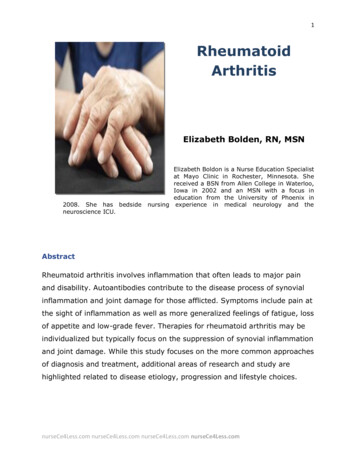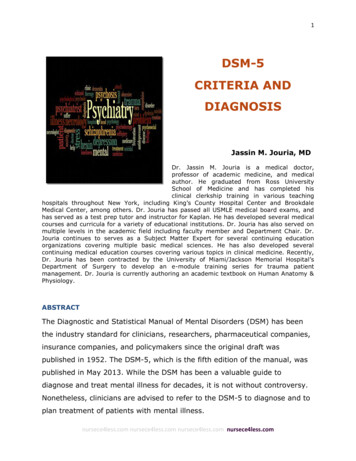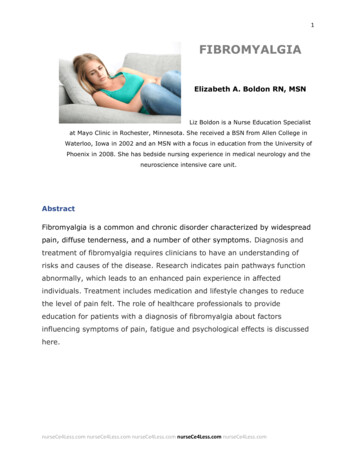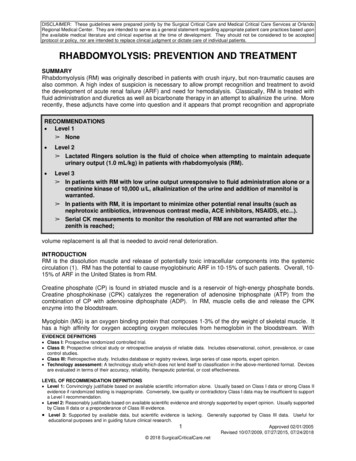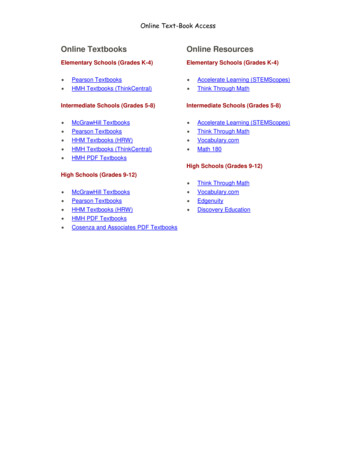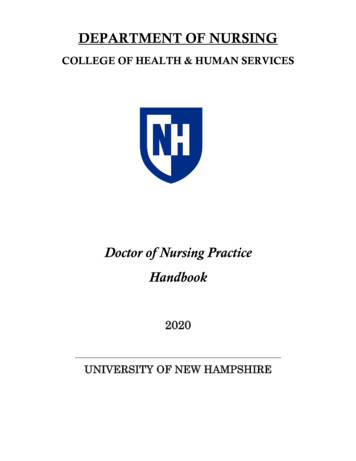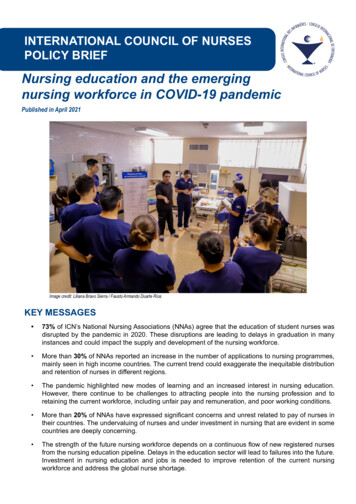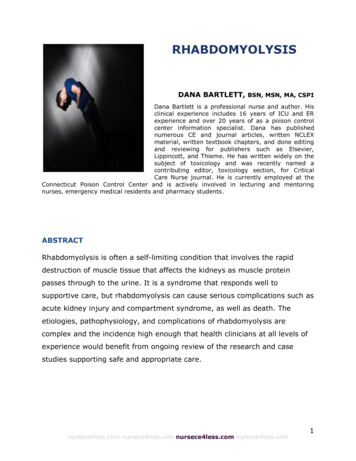
Transcription
RHABDOMYOLYSISDANA BARTLETT, BSN, MSN, MA, CSPIDana Bartlett is a professional nurse and author. Hisclinical experience includes 16 years of ICU and ERexperience and over 20 years of as a poison controlcenter information specialist. Dana has publishednumerous CE and journal articles, written NCLEXmaterial, written textbook chapters, and done editingand reviewing for publishers such as Elsevier,Lippincott, and Thieme. He has written widely on thesubject of toxicology and was recently named acontributing editor, toxicology section, for CriticalCare Nurse journal. He is currently employed at theConnecticut Poison Control Center and is actively involved in lecturing and mentoringnurses, emergency medical residents and pharmacy students.ABSTRACTRhabdomyolysis is often a self-limiting condition that involves the rapiddestruction of muscle tissue that affects the kidneys as muscle proteinpasses through to the urine. It is a syndrome that responds well tosupportive care, but rhabdomyolysis can cause serious complications such asacute kidney injury and compartment syndrome, as well as death. Theetiologies, pathophysiology, and complications of rhabdomyolysis arecomplex and the incidence high enough that health clinicians at all levels ofexperience would benefit from ongoing review of the research and casestudies supporting safe and appropriate care.nursece4less.com nursece4less.com nursece4less.com nursece4less.com1
Policy StatementThis activity has been planned and implemented in accordance with thepolicies of NurseCe4Less.com and the continuing nursing educationrequirements of the American Nurses Credentialing Center's Commission onAccreditation for registered nurses. It is the policy of NurseCe4Less.com toensure objectivity, transparency, and best practice in clinical education forall continuing nursing education (CNE) activities.Continuing Education Credit DesignationThis continuing education (CE) activity is credited for 2.5 hours. Nurses mayonly claim credit commensurate with the credit awarded for completion ofthis course activity.Statement of Learning NeedBecause rhabdomyolysis is often a self-limiting condition that can range inseverity and outcomes, including serious complications such as acute kidneyinjury and compartment syndrome, even death, health clinicians at all levelsof experience should be reviewing recommended diagnostic and treatmentapproaches for early diagnosis. The risk of patient mortality in thosediagnosed with rhabdomyolysis varies depending on multiple factors, someof which can be determined through laboratory and other diagnostic testing,and careful review of patient history and physical signs and symptoms.Course PurposeTo provide health clinicians with knowledge about rhabdomyolysis diagnosis,treatment and prognosis with early detection of symptoms and appropriatephysical evaluation and work up.nursece4less.com nursece4less.com nursece4less.com nursece4less.com2
Target AudienceAdvanced Practice Registered Nurses and Registered Nurses(Interdisciplinary Health Team Members, including Vocational Nurses andMedical Assistants may obtain a Certificate of Completion)Course Author & Planning Team Conflict of Interest DisclosuresDana Bartlett, BSN, MSN, MA, CSPI, William S. Cook, PhD, DouglasLawrence, MA, Susan DePasquale, MSN, FPMHNP-BC - all have nodisclosuresAcknowledgement of Commercial SupportThere is no commercial support for this course.Please take time to complete a self-assessment of knowledge, onpage 4, sample questions before reading the article.Opportunity to complete a self-assessment of knowledge learnedwill be provided at the end of the course.nursece4less.com nursece4less.com nursece4less.com nursece4less.com3
1. Rhabdomyolysis is a syndrome characterized bya.b.c.d.a breakdown of skeletal muscle.reduced serum levels of creatine kinase.reduced excretion of myoglobin by the kidneys.All of the above2. With rhabdomyolysis, regardless of the cause of the conditionthere is a common end-point, pathologic event calleda.b.c.d.skeletal muscle damage.hepatic failure.decreased urine output.compartment syndrome.3. Exertional rhabdomyolysis is caused bya.b.c.d.intense voluntary skeletal muscle activity.intense involuntary skeletal muscle activity.normal levels of exercise in inclement weather.All of the above4. True or False: All forms of rhabdomyolysis are rare, uncommonconditions that result from a traumatic event.a. Trueb. False5. Alcohol-induced rhabdomyolysisa. appears commonly with people who drink alcohol.b. may be caused by the direct, toxic effects of alcohol on themuscles.c. only occurs due to alcohol withdrawal syndrome.d. only occurs from acid-base imbalance caused by acute alcoholintoxication.nursece4less.com nursece4less.com nursece4less.com nursece4less.com4
IntroductionRhabdomyolysis is a syndrome characterized by a breakdown of skeletalmuscle, elevated serum levels of creatine kinase, and renal damage. It ismost often a self-limiting condition that responds well to supportive care,but rhabdomyolysis can cause death and serious complications like acutekidney injury and compartment syndrome. Rhabdomyolysis is a commonlyencountered condition, but the etiologies, pathophysiology, andcomplications of rhabdomyolysis are complex and even for experiencedhealth clinicians a review of these can be useful.Rhabdomyolysis: EtiologyThere are three primary etiologies of rhabdomyolysis - traumatic, exertional,and non-traumatic/non-exertional,1 but categorizing rhabdomyolysis in thisway, although useful for understanding the condition, is somewhat arbitrary.Many of the specific initiating causes of rhabdomyolysis; i.e., cocaineintoxication, may involve traumatic,exertional, and non-traumatic/nonexertional mechanisms, and for allthe causes of rhabdomyolysis thereis a common end-point, pathologicThe prefix rhabdo means rod-shapedand when examined closely, skeletalmuscle has a rod-shaped appearance.Myo means of or relating to muscles,and lysis is defined as destruction,decomposition.event – skeletal muscle damage.The terms listed below are helpful for understanding rhabdomyolysis. Acute Kidney Injury:A sudden decrease in renal function, characterized by an increase inserum creatinine and decreased urine output.nursece4less.com nursece4less.com nursece4less.com nursece4less.com5
Compartment Syndrome:Increased tissue pressure in a confined anatomical space that causesdecreased blood flow and ischemia. Creatine Kinase (CK):An intracellular enzyme that helps form adenosine diphosphate andphosphocreatine. There are three isoenzymes of CK; CK1 (BB) is foundprimarily in the brain, CK2 (MB) is found primarily in the heart, and CK3(MM) is found primarily in the muscle. Myoglobin:The primary intracellular oxygen-transporting molecule. Syndrome:A set of signs and symptoms that occur together.Traumatic RhabdomyolysisTraumatic rhabdomyolysis is a common pathology,2 and it is caused by directinjury or when a muscle is subjected to prolonged compression.1,3 Directinjury that causes rhabdomyolysis can be from blunt trauma, burns, a highvoltage electrical shock, the prolonged use of mechanical restraints, or as acomplication of using a tourniquet during a surgical procedure.1,3-7Prolonged compression to a muscle that leads to rhabdomyolysis is causedby immobilization. This can be caused by a medical condition like coma, adrug overdose, a stroke1,8 or from a surgical procedure that requires thepatient to be immobile for a lengthy period.1,7-9nursece4less.com nursece4less.com nursece4less.com nursece4less.com6
Exertional RhabdomyolysisExertional rhabdomyolysis is caused by intense voluntary or involuntaryskeletal muscle activity,1,10-12 or by a normal level of exercise that isperformed in extreme weather conditions.1,12 Rhabdomyolysis from voluntarymuscular contractions is almost always associated with exercise, bothendurance and resistance exercise, and exercise-related exertionalrhabdomyolysis typically occurs when experienced athletes suddenly anddramatically increase their level of training or when someone who haspreviously been sedentary begins a fitness program.Factors that increase the risk of developing exertional rhabdomyolysisinclude (but are not limited to) dehydration, genetic susceptibility,hot/humid weather, hypokalemia, male gender, and the type of exercise.10People who have recurrent episodes of exertional rhabdomyolysis most likelyhave a genetic susceptibility in the form of an undiagnosed metabolicmyopathy.10 Fortunately, although CK elevations caused by exercise are notunusual,10 exertional rhabdomyolysis and serious complications ofrhabdomyolysis are uncommon.10,13,14Involuntary muscular activity that causes rhabdomyolysis can be caused bygrand mal seizures, hyperthermia, psychiatric conditions like psychosis thatare associated with uncontrolled agitation, and by prescription and illicitdrugs like antipsychotics, amphetamines, cocaine, and 3,4methylenedioxymethamphetamine, aka ecstasy.1Non-traumatic/Non-exertional RhabdomyolysisCauses of non-traumatic/non-exertional rhabdomyolysis are discussed in thissection, and listed in Table 1.1,10,15nursece4less.com nursece4less.com nursece4less.com nursece4less.com7
Table 1: Non-Traumatic/Non-Exertional RhabdomyolysisAlcoholDelirium tremensDrug withdrawalElectrolyte abnormalitiesEndocrine disordersHyperthermiaIllicit drugsInfectionsMedical conditionsMetabolic myopathiesNear drowning and hypothermiaShockPrescription drugsToxinsVascular thrombosisThis list is not all-inclusive and pathologies like the metabolic myopathies arenot common, and toxins like bee venom rarely cause rhabdomyolysis.Several of the typically encountered etiologies of non-traumatic/nonexertional rhabdomyolysis are highlighted below. Some of these, i.e.,hyperthermia and stimulant intoxication are often accompanied byrhabdomyolysis; conditions like alcohol use and electrolytes abnormalitiesare very common, but rhabdomyolysis caused by them is not.Alcohol UseAlcohol use can cause rhabdomyolysis by one of the following mechanismsor by a combination of them - a direct toxic effect of alcohol on the muscles,immobilization subsequent to acute alcohol intoxication, and acid-base andelectrolyte abnormalities caused by chronic alcohol intake.15,16 Alcoholinduced rhabdomyolysis does not appear to be common, but alcohol is afrequent culprit when intoxication and/or drug use are examined as a causenursece4less.com nursece4less.com nursece4less.com nursece4less.com8
for rhabdomyolysis.17-19 Delirium tremens from alcohol withdrawal can becomplicated by rhabdomyolysis.Electrolyte AbnormalitiesAbnormally low levels of calcium, phosphate potassium, and sodium havebeen implicated as causing rhabdomyolysis and/or contributing to itsdevelopment, as has hypernatremia,10 and these electrolyte disturbances areassociated with specific clinical conditions.10,20-22Table 2: Electrolytes Disturbances and RhabdomyolysisHypernatremia – Dehydration, diabetesHypocalcemia - HypoparathyroidismHypokalemia - Diabetes, exertional rhabdomyolysisHyponatremia – Psychogenic polydipsiaHypophosphatemia – Alcohol use, diabetes, hyperalimentationHyperthermiaHyperthermia that causes rhabdomyolysis is a complication of stimulantintoxication and deliberate overdose of anticholinergics and monoamineoxidase (MAO) inhibitors. It is an adverse effect of prescription drugs likeantipsychotics, inhalational anesthetics, selective serotonin re-uptakeinhibitors (SSRIs),1,23,24 and rhabdomyolysis caused by high bodytemperature can result from intense physical activity, high ambienttemperatures, exertional rhabdomyolysis, drug withdrawal, and sepsis.1,25nursece4less.com nursece4less.com nursece4less.com nursece4less.com9
Illicit DrugsRhabdomyolysis is a common complication of intoxication from the illicitstimulants amphetamine, cocaine, ecstasy, phencyclidine (PCP), andsynthetic canthiones (commonly known as bath salts).1,26,27 These drugs aredirectly toxic to the skeletal muscles and they increase circulating levels ofcatecholamines and serotonin, causing agitation, hyperthermia, increasedskeletal muscle activity, increased body temperature, seizures, andvasoconstriction that results in tissue hypoxia.1,26,27 Heroin and other opioidscan also be directly toxic to skeletal muscle, and intoxication with an opioidis often accompanied by compartment syndrome, hypotension, hypoxia, andprolonged immobilization, all risk factors for rhabdomyolysis.InfectionsBacterial infections from E coli, Streptococcus, and other pathogens and viralinfections from influenza and herpes simplex have been associated withrhabdomyolysis.1 Infections are a common cause of rhabdomyolysis inchildren; this is less so in adults. The mechanism by which infection causesrhabdomyolysis is not known.1Prescription DrugsThere are many prescription and over-the-counter drugs that cause, or havebeen associated with rhabdomyolysis.1,8,28 Some of the more common onesare antipsychotics, antidepressants, antihistamines, benzodiazepines,colchicine, corticosteroids, and the statin drugs.1,8,28 The statin drugs aretaken by millions of people but the risk of developing rhabdomyolysis fromthe use of a statin is very small, and in most cases clearly identified riskfactors, particularly high doses and concurrent use of a drug that disruptsstatin metabolism, are involved.1,29-31nursece4less.com nursece4less.com nursece4less.com nursece4less.com10
ToxinsCarbon monoxide (CO) poisoning happens to millions of people each year,and rhabdomyolysis is not unusual in serious cases of CO poisoning.32 Bee,wasp, and other insect stings are an everyday occurrence, butrhabdomyolysis after these events is rare and usually happens if the patienthas suffered a massive number of stings.32 Snake and spider venoms cancause rhabdomyolysis, as well.Pathophysiology Of RhabdomyolysisThe different etiologies and the specific causes of rhabdomyolysis all resultin the same pathogenic pathway.1,3,
approaches for early diagnosis. The risk of patient mortality in those diagnosed with rhabdomyolysis varies depending on multiple factors, some of which can be determined through laboratory and other diagnostic testing, and careful review of patient history and
